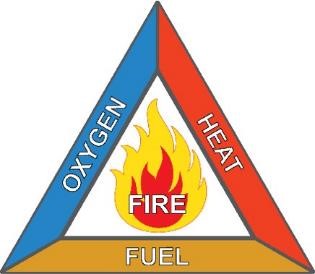Fire Protection
Fire prevention and protection procedures should be established.
The Fire Triangle guides the process for designing a lab and/or experiment to minimize the chance of a fire (Prevention) or extinguishing a fire if detected (Protection). Preventing or extinguishing a fire requires eliminating one or more of the three sides of the triangle.
Lab and experiment design should focus on minimizing the risk of fire.
Since it may not be possible to completely eliminate the risk of a fire, project teams should establish and document a strategy for extinguishing a fire if one is detected and train lab personnel on what to do.
The most effective way to extinguish a hydrogen fire is to shut off the flow of hydrogen. Therefore, an emergency shutoff valve on the hydrogen supply piping should be installed which can be activated manually, by operator-actuated emergency stop (E-Stop) controls, and by an automatic alarm system.
If the hydrogen supply cannot be shut off, then letting a fire burn until available hydrogen is consumed may be the best approach to avoid accumulating a flammable cloud and creating a possible hydrogen explosion.
Fire extinguishing agents should be carefully selected considering all of the materials in the lab.
Manual fire extinguishers should be provided if appropriate for the materials in the lab. If provided, personnel should be trained to use them.
Depending on laboratory arrangements and the quantities of hydrogen and other flammable gases in the lab, consideration should be given to the installation of an automatic fire extinguishing system (per NFPA 45).
The design and installation of fire detection and alarm systems (per NFPA 45) should be considered.
Laboratory designers should consult with the authority having jurisdiction regarding specific requirements of the local fire and building codes.
The following should be given special fire prevention consideration:
- Handling and storage of gaseous and liquid hydrogen.
- Control of any heat sources or potential ignition sources
- A work permit system for using open flames or spark-producing equipment.
- Arrangements and use of portable electric cords.
- Smoking area controls.


